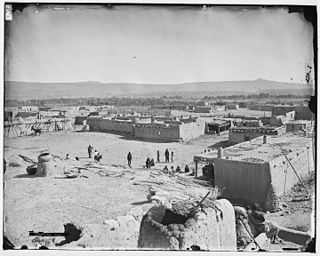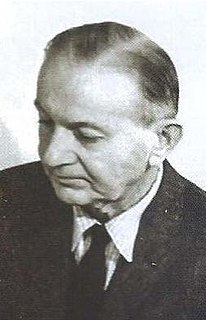The Puebloans or Pueblo peoples, are Native Americans in the Southwestern United States who share common agricultural, material, and religious practices. Pueblo, which means "village" in Spanish, was a term originating with the Colonial Spanish, who used it to refer to the people's particular style of dwelling.

A kachina is a spirit being in the religious beliefs of the Pueblo peoples, Native American cultures located in the south-western part of the United States. In the Pueblo cultures, kachina rites are practiced by the Hopi, Zuni, Hopi-Tewa, and certain Keresan tribes, as well as in most Pueblo tribes in New Mexico.

South Tucson is a city in Pima County, Arizona, United States and an enclave of the much larger city of Tucson. South Tucson is known for being heavily influenced by Hispanic, and especially Mexican, culture; restaurants and shops which sell traditional Mexican food and other goods can be found throughout the city. According to the 2010 census, the population of the city is 5,652.

Cochiti is a census-designated place (CDP) in Sandoval County, New Mexico, United States. A historic pueblo of the Cochiti people, it is part of the Albuquerque Metropolitan Statistical Area. The population was 528 at the 2010 census. Located 22 miles (35 km) southwest of Santa Fe, the community is listed as a historic district on the National Register of Historic Places.

The Zuni are Native American Pueblo peoples native to the Zuni River valley. Today, the Zuni are a Federally recognized tribe and most live in the Pueblo of Zuni on the Zuni River, a tributary of the Little Colorado River, in western New Mexico, United States. The Pueblo of Zuni is 55 km (34 mi) south of Gallup, New Mexico. The Zuni tribe lived in multi level adobe houses. In addition to the reservation, the tribe owns trust lands in Catron County, New Mexico, and Apache County, Arizona. The Zuni call their homeland Halona Idiwan’a or Middle Place. The word Zuni is believed to derive from the Western Keres language (Acoma) word sɨ̂‧ni, or a cognate thereof.

Leslie Marmon Silko is an American writer. A Laguna Pueblo Indian woman, she is one of the key figures in the First Wave of what literary critic Kenneth Lincoln has called the Native American Renaissance.

Alexander Girard, affectionately known as Sandro, was an architect, interior designer, furniture designer, industrial designer, and a textile designer.
Leonidas Tapia (?-1977) was a Puebloan potter from Ohkay Owingeh, New Mexico, United States. She was the wife of Jose Blas Tapia and mother of Mary Trujillo and Tom Tapia. Leonidas made traditional San Juan polychrome redware bowls, jars and wedding vases. She also made micaceous pottery. Some of the designs she used on her pottery include the water serpent, kiva steps and clouds. Leonidas participated in the Santa Fe Indian Market from 1970-1976.
In Hopi mythology Nataska is the uncle of the family of "ogre Katsinas" who guard Soyok Wuhti, and who enforce good behavior among the children. Nataska is a Mongkatsina. Wiharu is a similar or identical Katsina with a white rather than black face.

Helen Cordero was a Cochiti Pueblo potter from Cochiti, New Mexico. She was renowned for her storyteller pottery figurines, a motif she invented, based upon the traditional "singing mother" motif.
Tales of the Cochiti Indians is a 1931 work by Ruth Benedict. It collects the folk tales of the Cochiti Puebloan peoples in New Mexico. The book is considered an important work in the discipline of feminist anthropology. Following development of the "culture and personality" school of anthropology by her colleague Edward Sapir and influenced by Margaret Mead, Benedict sought psychological patterns in the stories she collected.

Art of the American Southwest is the visual arts of the Southwestern United States. This region encompasses Arizona, New Mexico, and parts of California, Colorado, Nevada, Texas, and Utah. These arts include architecture, ceramics, drawing, filmmaking, painting, photography, sculpture, printmaking, and other media, ranging from the ancient past to the contemporary arts of the present day.
Virgil Ortiz is a Pueblo artist, known for his pottery and fashion design from Cochiti Pueblo, New Mexico. Ortiz makes a variety of pottery, including traditional Cochiti figurative pottery, experimental figurative pottery, traditional pottery vessels. His clothing and jewelry designs are influenced by traditional Native American pattern and aesthetics. He is best known for his edgy pottery figures, his contemporary take on the traditional Cochiti pottery figures (monos) from the late 1800s.

Ida Redbird (1892-1971) was a Maricopa potter from the Gila River Indian Community of the Gila River Indian Reservation in Arizona. She was the first president of the Maricopa Pottery Maker's Association and was widely credited with the revival of ancient Maricopa pottery techniques and forms. Her polished black-on-redware pottery was highly prized with collectors. Texas photographer Ted Sayles shot a series documenting Redbird sculpting her pottery. The series toured museums throughout the Western United States

Mary Ellen Toya (1934–1990) was a Jemez Pueblo potter of the Water Clan. She was active ca. 1950–1990, and was known for creating some of the largest Storyteller figures.
Juanita Inez Ortiz, also known as Inez Ortiz was a Native American Cochiti Pueblo artist, specializing in pottery. She is of the Herrera family of Pueblo potters in New Mexico, whose work is often found in art collections and in art museums. She was from the Cochiti Pueblo in Cochiti, New Mexico.
Laurencita R. Herrera (1912–1984) was a renowned Native American Cochiti Pueblo artist, specializing in traditional Cochiti figurative pottery called storytellers and her pottery vessels. She is of the Herrera family, a renowned family of Pueblo potters in New Mexico, whose work is often found in art collections and in art museums. She was an actively making pottery between the 1930s through the 1970s and is known as one of the, "finest Cochiti potters of that era".
Barbara Ann Babcock was an American folklore scholar, professor of Comparative Cultural and Literary Studies, Women's Studies, and American Indian Studies at the University of Arizona.

Pueblo pottery are ceramic objects made by the indigenous Pueblo people and their antecedents, the Ancestral Puebloans and Mogollon cultures in the Southwestern United States and Northern Mexico. For centuries, pottery has been central to pueblo life as a feature of ceremonial and utilitarian usage. The clay is locally sourced, most frequently handmade, and fired traditionally in an earthen pit. These items take the form of storage jars, canteens, serving bowls, seed jars, and ladles, serving the needs of daily life. Some utility wares were undecorated except from simple corrugations or marks made with a stick or fingernail, however many examples for centuries were painted with abstract or representational motifs. Some pueblos made effigy vessels, fetishes or figurines such as Cochiti Pueblo. During modern times, pueblo pottery was produced specifically as an art form to serve an economic function. This role is not dissimilar to prehistoric times when pottery was traded throughout the Southwest, and in historic times after contact with the Spanish colonialists.
Rosalie Simbola Aguilar was a Pueblo-American potter from the Picurís tribe. She is known for her black-on-black pottery and for her creation circa 1931 of a technique in which contrasting carved heights were accentuated with glossy or dull coating. Simbola often collaborated with her husband, José Angela Aguilar, who would carve and paint her creations. By the 1930s her pottery was exhibited nationally along with contemporaries like Rose Gonzales, Maria Martinez, Juanita Pena and Tonita Roybal. Simbola's works are in the permanent collection of institutions including the Denver Museum of Natural History.











